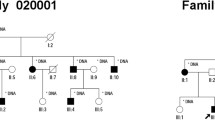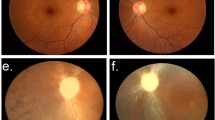Abstract
Mutation in the PROM1 gene previously has been identified in one family with retinal degeneration for which neither ERG recordings nor detailed information about visual impairment is available. A large family with multiple individuals affected by retinal degeneration was ascertained in the Punjab province of Pakistan. The visual acuity of all affected patients in the family was severely compromised beginning in early childhood. The retinal disease in this family is a severe form of retinitis pigmentosa (RP) accompanied by macular degeneration. Fundus changes advanced with age. Choriocapillaris atrophy and posterior RPE atrophy were obvious allowing visualization of the large choroidal vessels in patients over 40 years of age. Rod and cone responses on ERG recordings were extinguished in patient’s teens. A genome-wide scan mapped the disease to a 34.7 cM region of chromosome 4p14–p16 between D4S1599 and D4S405. A maximum lod score of 3.96 with D4S403 and D4S391 is seen at θ = 0. Sequence analysis of PROM1 located in the linkage interval identified a c.1726C>T homozygous transition in exon 15: resulting in p.Gln576X in the translated protein. This mutation is found in a homozygous state in all six affected individuals and was heterozygous in five of the six unaffected family members examined. The mutation was not detected in 192 chromosomes of unrelated control individuals of the same ethnicity and from the same region. This delineates the phenotypic characteristics of retinopathy caused by mutations in PROM1.




Similar content being viewed by others
References
Boughman JA, Conneally PM, Nance WE (1980) Population genetic studies of retinitis pigmentosa. Am J Hum Genet 32:223–235
Buch H, Vinding T, La Cour M, Appleyard M, Jensen GB, Nielsen NV (2004) Prevalence and causes of visual impairment and blindness among 9980 Scandinavian adults: the Copenhagen City Eye Study. Ophthalmology 111:53–61
Burstedt MS, Forsman-Semb K, Golovleva I, Janunger T, Wachtmeister L, Sandgren O (2001) Ocular phenotype of bothnia dystrophy, an autosomal recessive retinitis pigmentosa associated with an R234W mutation in the RLBP1 gene. Arch Ophthalmol 119:260–267
Cremers FP, van de Pol DJ, van Driel M, den Hollander AI, van Haren FJ, Knoers NV, Tijmes N, Bergen AA, Rohrschneider K, Blankenagel A, Pinckers AJ, Deutman AF, Hoyng CB (1998) Autosomal recessive retinitis pigmentosa and cone-rod dystrophy caused by splice site mutations in the Stargardt’s disease gene ABCR. Hum Mol Genet 7:355–362
Evans K, Duvall-Young J, Fitzke FW, Arden GB, Bhattacharya SS, Bird AC (1995) Chromosome 19q cone-rod retinal dystrophy. Ocular phenotype Arch Ophthalmol 113:195–201
Fargeas CA, Huttner WB, Corbeil D (2007) Nomenclature of prominin-1 (CD133) splice variants-an update. Tissue Antigens 69:602–606
Gregory-Evans K, Kelsell RE, Gregory-Evans CY, Downes SM, Fitzke FW, Holder GE, Simunovic M, Mollon JD, Taylor R, Hunt DM, Bird AC, Moore AT (2000) Autosomal dominant cone-rod retinal dystrophy (CORD6) from heterozygous mutation of GUCY2D, which encodes retinal guanylate cyclase. Ophthalmology 107:55–61
Heckenlively JR, Yoser SL, Friedman LH, Oversier JJ (1988) Clinical findings and common symptoms in retinitis pigmentosa. Am J Ophthalmol 105:504–511
Hentze MW, Kulozik AE (1999) A perfect message: RNA surveillance and nonsense-mediated decay. Cell 96:307–310
Jaszai J, Fargeas CA, Florek M, Huttner WB, Corbeil D (2006) Focus on Molecules: Prominin-1 (CD133). Exp Eye Res
Klevering BJ, van Driel M, van de Pol DJ, Pinckers AJ, Cremers FP, Hoyng CB (1999) Phenotypic variations in a family with retinal dystrophy as result of different mutations in the ABCR gene. Br J Ophthalmol 83:914–918
Kniazeva M, Chiang MF, Morgan B, Anduze AL, Zack DJ, Han M, Zhang K (1999) A new locus for autosomal dominant stargardt-like disease maps to chromosome 4. Am J Hum Genet 64:1394–1399
Li A, Jiao X, Munier FL, Schorderet DF, Yao W, Iwata F, Hayakawa M, Kanai A, Shy Chen M, Alan Lewis R, Heckenlively J, Weleber RG, Traboulsi EI, Zhang Q, Xiao X, Kaiser-Kupfer M, Sergeev YV, Hejtmancik JF (2004) Bietti crystalline corneoretinal dystrophy is caused by mutations in the novel gene CYP4V2. Am J Hum Genet 74:817–826
Marmor MF, Holder GE, Seeliger MW, Yamamoto S (2004) Standard for clinical electroretinography (2004 update). Doc Ophthalmol 108:107–114
Martinez-Mir A, Bayes M, Vilageliu L, Grinberg D, Ayuso C, del Rio T, Garcia-Sandoval B, Bussaglia E, Baiget M, Gonzalez-Duarte R, Balcells S (1997) A new locus for autosomal recessive retinitis pigmentosa (RP19) maps to 1p13–1p21. Genomics 40:142–146
Martinez-Mir A, Paloma E, Allikmets R, Ayuso C, del Rio T, Dean M, Vilageliu L, Gonzalez-Duarte R, Balcells S (1998) Retinitis pigmentosa caused by a homozygous mutation in the Stargardt disease gene ABCR. Nat Genet 18:11–12
Maw MA, Corbeil D, Koch J, Hellwig A, Wilson-Wheeler JC, Bridges RJ, Kumaramanickavel G, John S, Nancarrow D, Roper K, Weigmann A, Huttner WB, Denton MJ (2000) A frameshift mutation in prominin (mouse)-like 1 causes human retinal degeneration. Hum Mol Genet 9:27–34
McHenry CL, Liu Y, Feng W, Nair AR, Feathers KL, Ding X, Gal A, Vollrath D, Sieving PA, Thompson DA (2004) MERTK arginine-844-cysteine in a patient with severe rod-cone dystrophy: loss of mutant protein function in transfected cells. Invest Ophthalmol Vis Sci 45:1456–1463
Michaelides M, Hunt DM, Moore AT (2003a) The genetics of inherited macular dystrophies. J Med Genet 40:641–650
Michaelides M, Johnson S, Poulson A, Bradshaw K, Bellmann C, Hunt DM, Moore AT (2003b) An autosomal dominant bull’s-eye macular dystrophy (MCDR2) that maps to the short arm of chromosome 4. Invest Ophthalmol Vis Sci 44:1657–1662
Miraglia S, Godfrey W, Yin AH, Atkins K, Warnke R, Holden JT, Bray RA, Waller EK, Buck DW (1997) A novel five-transmembrane hematopoietic stem cell antigen: isolation, characterization, and molecular cloning. Blood 90:5013–5021
Small KW, Gehrs K (1996) Clinical study of a large family with autosomal dominant progressive cone degeneration. Am J Ophthalmol 121:1–12
Tuson M, Marfany G, Gonzalez-Duarte R (2004) Mutation of CERKL, a novel human ceramide kinase gene, causes autosomal recessive retinitis pigmentosa (RP26). Am J Hum Genet 74:128–138
Weigmann A, Corbeil D, Hellwig A, Huttner WB (1997) Prominin, a novel microvilli-specific polytopic membrane protein of the apical surface of epithelial cells, is targeted to plasmalemmal protrusions of non-epithelial cells. Proc Natl Acad Sci USA 94:12425–12430
Yin AH, Miraglia S, Zanjani ED, Almeida-Porada G, Ogawa M, Leary AG, Olweus J, Kearney J, Buck DW (1997) AC133, a novel marker for human hematopoietic stem and progenitor cells. Blood 90:5002–5012
Zelhof AC, Hardy RW, Becker A, Zuker CS (2006) Transforming the architecture of compound eyes. Nature 443:696–699
Zhang Q, Zulfiqar F, Xiao X, Amer Riazuddin S, Ayyagari R, Sabar F, Caruso R, Sieving PA, Riazuddin S, Fielding Hejtmancik J (2005) Severe autosomal recessive retinitis pigmentosa maps to chromosome 1p13.3–p21.2 between D1S2896 and D1S457 but outside ABCA4. Hum Genet 118:356–365
Zhang Q, Li S, Xiao X, Jia X, Guo X (2007) The 208delG mutation in FSCN2 does not associate with retinal degeneration in Chinese individuals. Invest Ophthalmol Vis Sci 48:530–533
Acknowledgments
We are grateful to the families for their participation in this study. We sincerely thank the staff of Lyton Rehmatullah Benevolent Trust (LRBT) Hospital for the identification of the families and collection of clinical information. We also thank Ms. Afshan Yasmeen, Ms. Shagufta Begum, and Mr. Farooq Sabar for their technical help. Dr. Qingjiong Zhang is a recipient of Fok Ying Tung Education Foundation (6041) and of a fund from National Natural Science Foundation of China (30572006 to QZ).
Author information
Authors and Affiliations
Corresponding authors
Additional information
Qingjiong Zhang, Fareeha Zulfiqar, Xueshan Xiao, Sheikh Riazuddin and J. Fielding Hejtmancik contributed equally.
Rights and permissions
About this article
Cite this article
Zhang, Q., Zulfiqar, F., Xiao, X. et al. Severe retinitis pigmentosa mapped to 4p15 and associated with a novel mutation in the PROM1 gene. Hum Genet 122, 293–299 (2007). https://doi.org/10.1007/s00439-007-0395-2
Received:
Accepted:
Published:
Issue Date:
DOI: https://doi.org/10.1007/s00439-007-0395-2




